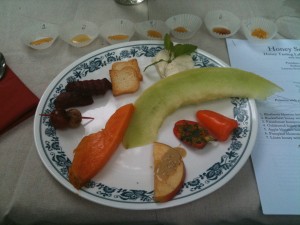 So what, exactly, do wine and honey have in common? More than you might think. Many people are familiar with mead, a centuries old honey wine often attributed with being the oldest alcoholic drink in the world. But last weekend, it was not wine that was being tasted. WINE attended a honey tasting laboratory at Red Bee in Weston. It was an eye-opening experience, to say the least.
So what, exactly, do wine and honey have in common? More than you might think. Many people are familiar with mead, a centuries old honey wine often attributed with being the oldest alcoholic drink in the world. But last weekend, it was not wine that was being tasted. WINE attended a honey tasting laboratory at Red Bee in Weston. It was an eye-opening experience, to say the least.
As guests arrived at the charming red house with a bee painted on the side, nestled amongst the chicken coops, open gardens and colorful beehives, we were treated to a glass of Prosecco adorned with a floating raspberry. Doing the pouring was seasoned beekeeper, Al Avitabile, here to support the main act, honey sommelier, Marina Marchese. The term “honey sommelier,” coined by Ms. Marchese, was the first of many similarities to the wine world I was about to discover here.
Once all of the guests had arrived from Connecticut, Massachusetts and New York, Ms. Marchese began her story of how she accidentally became a beekeeper. Her fascinating tale was periodically accentuated by the crow of a rooster, an unwelcome interruption to Ms. Marchese, but one the audience found to be a delightful touch that lent an even greater note of charm to the experience. Ms. Marchese’s story is serendipitous and entertaining, and best left for Ms. Marchese, herself, to tell. You can hear the story in her own words if you follow this link: https://www.facebook.com/pages/Wine-Institute-of-New-England/141753879218706
After regaling us with her fairytale-esque story, we were led to a banquet table, complete with white linens, on the other side of the yard. The table was set with water glasses, silverware, baskets of homemade bread from the Fairfield Bread Company, and tasting notes. Once seated, the knowledgeable and amicable staff set white plates with tasting foods in front of each guest. The goat cheese with lemon balm was placed at 12 o’clock so that the pairings would flow clockwise. Just above each plate were seven paper mini-muffin cups numbered 1 through 7, each containing its own type of honey. For the next hour, our personal honey sommelier led us through honey tastings and pairings in a manner similar to a wine professional conducting a wine pairing. Pumpkin honey with sweet potato, linden honey with honeydew melon, buckwheat honey with beets or raw chocolate truffles, and blueberry blossom honey with the goat cheese. It was like taking up a new sport and discovering muscles you never knew you had. Each pairing made me feel like I was tasting food for the first time. And while I definitely preferred some of the pairings to others, each was credible and provocative.
Throughout this tasting hour, Ms. Marchese stood at the head of the table and spoke about her honey, intermittently fielding questions from the tasters. A confident, natural and engaging speaker, the beekeeper exhibited her command of the subject matter. I was thoroughly impressed and entertained. Our last tasting was a beautiful golden honey still in the honeycomb. It is here you find the magical propolis, a combination of plant resin and bee secretions responsible for providing numerous health benefits. Learning to taste the honey while chewing the wax, and then disposing of the wax, may be an acquired talent, but one that is well worth the effort.
The ride home gave me time to reflect on the experience. I was tickled by the way this new world, and my world of wine, paralleled each other. Sommeliers, tastings, pairings. But it went further than that. I have always been a big proponent of wines that reflect their terroir.* I am uneasy with some of the measures taken during the vinification process to achieve particular colors, aromas and flavors. I am also keenly aware of the difficulty of producing a quality wine without the aid of certain human intervention. It is a complex and hotly debated topic. What struck me about these delectable, single-origin nectar honeys was how pure these foods were. They were pure expressions of their terroir, without any transformations or intervention by humans. I was envious and amused. Humankind strives to mimic that which Mother Nature achieves naturally, and with perfection. I have vowed to incorporate honey into my gustatory habits. I am even interested in taking tasting to the next level – I would like to try the same variety of honey harvested from different regions. Sort of like comparing a Loire sauvignon blanc to one from New Zealand. There is so much tasting to be done. And Marina, I promise, no more plastic honey bears.
*Terroir is a French word, which has no exact English translation, that is used to mean the various influences that contribute to the taste of wine grapes, including climate, geography, and soil. Every vineyard has a unique terroir.